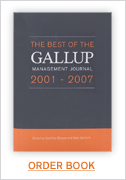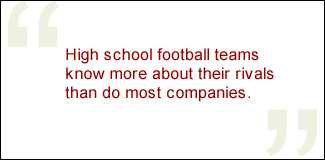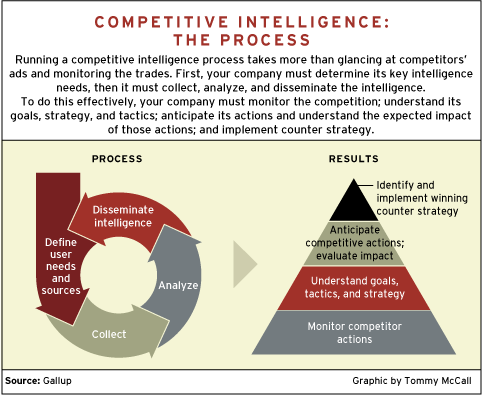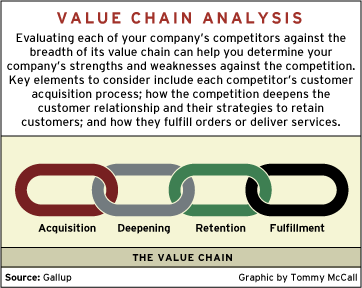During the Cold War, the CIA and the KGB crouched on either side of the Iron Curtain, watching every move the other made. The CIA read everything the Russians let out, debriefed defectors, tracked methods, analyzed motives, scrutinized leaders, and matched the USSR move for move. It was called tradecraft, and it was systematic, rigorous, and -- in most cases -- highly effective. I can attest to this, because I saw Cold War tradecraft firsthand during my 12 years as a CIA and naval intelligence officer.
 |
Businesses today are developing their own systems of tradecraft for some of the same reasons we did in the CIA: They want to gain a competitive advantage through a better understanding of the competition and the environment in which they operate. In the business world, tradecraft is called "competitive intelligence" (CI), and it is not industrial espionage; illegal or unethical actions have serious repercussions. CI is a structured, judicious method of informing business strategy. More importantly, it's an innovation engine that drives better business outcomes.
Making the case for CI
If your company knows nothing more about your competitors than they know about you, or if your offerings are identical to everyone else's in your industry, your business will be unable to differentiate its products, services, or brands. CI offers a framework that helps companies break away from the pack. It gives businesses a means to scan for threats from rival companies, to be optimally configured and properly positioned to confront those threats, and to adapt quickly to changes in the competitive environment. And when it's done well, CI creates significantly more value for businesses than it costs.
A recent Trendsetter Barometer survey from PricewaterhouseCoopers found that CEOs of fast-growth companies who rated CI as being either "very" or "critically" important increased revenues by 14.2 %, versus 11.8% for all others. Merck, the pharmaceutical giant, says its CI efforts saved the company $200 million in 30 months. After I implemented a CI system in a major U.S. financial services company, within 18 months, ROI to the bank was 10 times the cost of implementation, while the revenue impact was in the tens of millions of dollars. In this article, I'll share key insights from what I have learned from my hands-on experience.
 |
The framework
Most businesses already engage in some form of CI: They note the ads of their competitors, read up on them in the Wall Street Journal, or check out their rivals' Web sites. Open-source materials like these serve a purpose, but the information gleaned from them rarely reaches the right people at the right time. In reality, many Fortune 500 businesses remain woefully unprepared to understand and counter threats from competitors. High school football teams know more about their rivals than do most companies.
Good CI is vastly more organized and judicious than merely noting competitors' ads and reading the trades. Its basic framework involves determining your company's key intelligence questions, then collecting, analyzing, and disseminating the intelligence. To do this effectively, a company monitors the competition; understands its goals, strategy, and tactics; anticipates its actions and understands the expected impact of those actions; and implements counter strategies. (See graphic "The Competitive Intelligence Process.") It sounds simple enough, but the components of the framework matter.
 |
Much like our Cold War national defense posture, the CI framework is a strategic triad; its key components are an internal collection system, an external collection system, and a competitor analysis function. The first, the internal collection system, is the most overlooked. It requires human intelligence deployed in the field -- in other words, "boots on the ground."
Companies can start developing an internal collection system by interviewing employees who know the competition personally and intimately in some way. CI staff should question former employees of the competition according to legal and ethical standards (not within the first 90 days of employment; don't ask for trade secrets; keep the environment pressure-free). Ask them soft questions, such as What did you like about working there? What didn't you like? Why did you leave? What's the culture like? What are the primary differences between your former and current workplaces?
But "defectors" aren't the only source of intelligence. For example, CI staff can also take field trips to visit competitors' locations (though it's unethical for them to deliberately misrepresent themselves). Trade shows are also an excellent source of information. When employees attend these shows, they should look closely at the competition: What are they offering? How are they marketing it? What response did they get? How many people did they send? In this instance, "boots on the ground" can gather information efficiently and effectively on the products or services your competitors are offering -- and on how well they were received.
The second component is the external collection system, which uncovers market and customer intelligence. As mentioned previously, open-source material falls into this category, but again, that's just a small part of the information available for analysis. Comprehensive external collection systems can provide an early warning of changes in competitive conditions. CI staff use a disciplined approach to collect this information, including probing the unmet needs of new and potential clients; analyzing the strategies and messaging tactics used by the competition to acquire new clients; and surveying competitors' customers to identify weaknesses to exploit and risks to mitigate. CI staff should discover what keeps counterpart execs up at night; they should listen closely to what customers say when they switch from a competitor. Essentially, they should know their competitors' customers better than their competitors do.
The third component, competitor analysis function, has several key parts, including value chain analysis (VCA), leadership, and simulation intelligence.
- VCA takes an in-depth look at a competitor's products, services, and processes to identify the linchpins of its competitive advantages (or weaknesses) across the competitor's value chain, from customer acquisition and deepening the customer relationship to retention and fulfillment. (See graphic "Value Chain Analysis.") For example, a company can use this approach to pinpoint that the source of revenue growth at a key competitor is its new client acquisition strategy; the company then knows where to focus its efforts against that competitor.
 |
- Leadership intelligence involves analyzing key competitor staff, including their motivations, decision-making styles and processes, personality and behavior weaknesses to exploit, and strengths to counter. This analysis will help you better understand your competitors' leadership tendencies -- and the moves their leadership is likely to make.
- Simulation intelligence is a systematic process that uses "what-if" scenario planning and "war games." When conducted jointly with key company decision makers in a workshop environment, this process can uncover unseen opportunities for the company to boost competitive advantages. This requires bold, creative thinking -- and it's actually a lot of fun.
Let's say, for example, that your company is rolling out a new product launch. You could build on the knowledge you've gained -- from "defectors" during the internal collections process or from external collections sources such as trade shows -- to conduct a "war game." By matching your key executive intelligence consumers against the CI unit, you can play out how your leading competitors might respond to the new product launch. You can then use the results to preempt likely competitor attempts to counter your product launch.
Integration
To get results, CI requires tight organization and constant innovation. But even the best intelligence is useless if it doesn't get to the right people in the right way. An effective CI system requires a nerve center or a department of its own, and a small, nimble CI unit is much more valuable than a large, slow-moving one. The bank I mentioned had a CI center staffed with 10 people, and that was all that was needed to support an organization with more than 170,000 employees. A staff of two, or three, or even just one, can be sufficient for smaller organizations, as long as its leader has authority and clearance. In other words, the CI manager must be integrated into the worklife of the company's strategists; he or she must be a partner to the people who make decisions and must be at the center of the CI neural network.
 |
The CI manager must also be visible; the entire company should understand the goals and methods of the CI team. They should also know the process for reporting intelligence, and perhaps be rewarded for doing it. Above all, the CI team should stress ethics; they should promote the importance of the information they contribute to the company and the value they add to the bottom line.
I have noticed that CI units are most successful when they have an in-house champion. The champion doesn't necessarily need to be on the team, but he or she does need the ear of C-level execs. And the best teams are those staffed with good strategic thinkers. The CI manager doesn't need to poach the company's best analysts from other teams, but CI does require creativity and critical thinking.
In addition, because customers and employees are a vital part of effective CI, this process works best in companies that have engaged customers and employees. Though high engagement levels aren't strictly necessary, they do help -- engaged employees are more likely to think about competitor intelligence, look for it, recognize it, and forward it to the CI unit. And engaged customers are significantly more willing to discuss what they like about your business and what they dislike about your competitor. Furthermore, talking with engaged customers can help the CI unit identify strategic flaws in your rivals that your company can exploit; it can also help you spot your company's strategic weaknesses so you can take defensive action. When a business has high employee and customer engagement, and thorough CI, it has a rare opportunity to see threats from every direction, enabling the company to mount and deploy the appropriate response.
Innovation factory
Good tradecraft builds on itself. When ideas gathered from customer and employee feedback are added to what CI learns from external sources, it can lead to incremental innovations in products and services at the business unit level. By adding intelligence from competitive analysis to this mix, senior management has the information it needs to "connect the dots" to identify market gaps. Through the intelligence it collects and analyzes, the CI center can become an innovation factory for the company. Robust concept development and prototyping processes start rolling out. These ideas translate into strategies that cross business units and feed project teams, who then take the ideas from development to execution.
These key success factors indicate whether or not a CI unit is functioning at its peak. A top-performing CI unit:
- demonstrates that it creates a unique value -- value that would not have existed without the CI function
- leverages unique, primary human source intelligence to build an innovation engine. If all its information is coming from publicly available open sources, the CI unit isn't probing deeply enough.
- incorporates all available information from existing customer and employee engagement work
- focuses on the company's most pressing strategic "points of pain." Its most valuable intelligence is information that can help solve these problems.
- ensures that all its activities are conducted within strict legal and ethical guidelines
Avoiding the pitfalls
I have observed organizations that implemented competitive intelligence units, but -- in spite of good intentions and high hopes -- their efforts have failed. That's because there are a few common pitfalls that hobble CI before it even gets off the ground. One drawback is putting the CI unit too low in the organizational hierarchy. In most organizations, decisions and strategies are made on the executive level, so the CI unit needs to report to the CEO, the CMO, or the head of strategy/strategic planning. But at the same time, the CI unit needs to provide detailed information at the local level; for instance, if it knows a competitor is launching an offering in a single market, the CI team needs to alert the company's locations in that market in plenty of time to counter the threat.
Another snag comes from a lack of common processes. Too many methods of reporting, analysis, and evaluation are confusing, and employees will soon ignore them -- and this can be a serious problem for a team that depends heavily on volunteered information. Further, inadequate governance of legal and ethical norms will doom the CI unit and could possibly invite legal trouble. And finally, the CI team will be perceived as valuable if it is seen to create value. For that reason, inadequate measurement and reporting of its performance will undermine a CI venture, even if the unit is highly successful.
Game on
Competitive intelligence looks, and is, complex, rigorous, highly organized, and smart. But it's another thing, too: CI is a lot of fun. There's a reason people like reading spy novels and flock to James Bond movies -- among other things, they're exciting because the tradecraft is exciting. Pitting your best minds against those of your opponent is invigorating; besting the other guy is the thrill many of us have chased since we joined the business world. That spirit is an important part of the CI toolkit -- and it's one that quickly spreads to the rest of the organization. And with engagement like that, how can you lose?